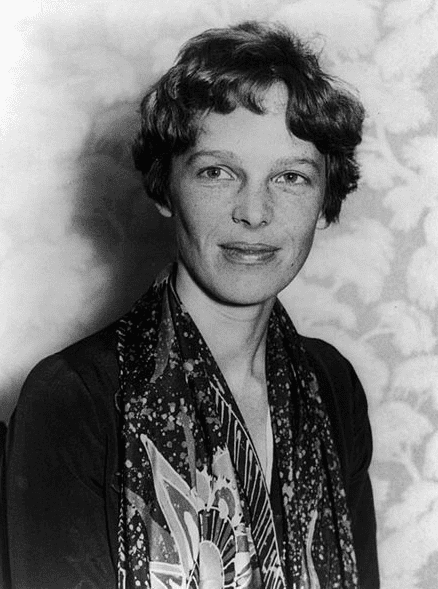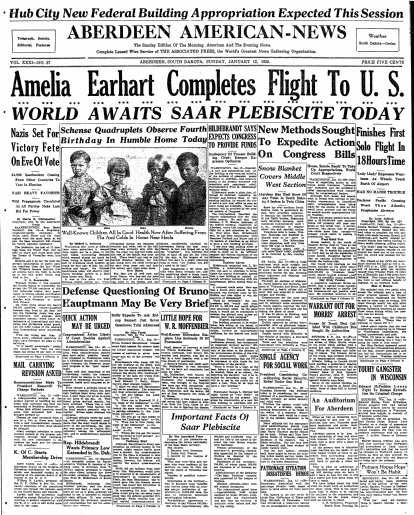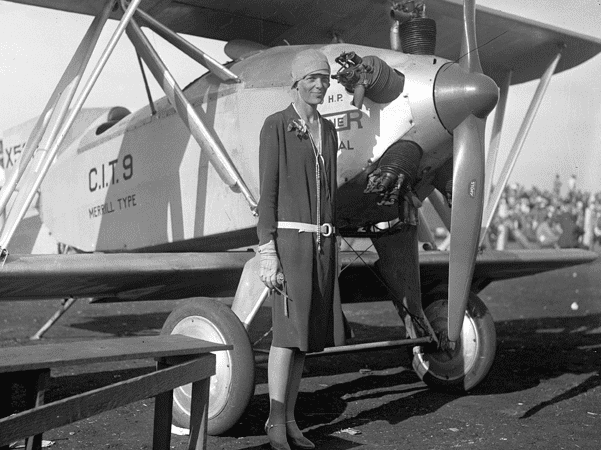Amelia Earhart electrified the world during the 1920s and ’30s with her daring feats of flying and the many aviation records she set. In 1932 she became the first woman to fly solo across the Atlantic – for this 15-hour feat of endurance and pluck she became the first woman to receive the Distinguished Flying Cross. That same year, she became the first woman to fly nonstop across the U.S.

Then, on this day in 1935, Earhart took off from Hawaii and became the first pilot, male or female, to fly solo from Hawaii to California, accomplishing this unprecedented feat in a grueling 18 hours.
Earhart was an established celebrity by the time of her 1935 Hawaii-California flight, with huge crowds greeting her public appearances and record-setting flights. During the last three hours of her Hawaii-California flight there had been no radio contact with her, yet when she landed in Oakland, California, on January 12 a rapturous crowd of 5,000 people awaited her, showering her and her plane with flowers and eagerly reaching to shake her hand.
Earhart’s record-setting flight was big news at the time, and was featured prominently on the front pages of the nation’s newspapers – such as this one from South Dakota.

This article gave details of her challenging flight, and the wild, cheering reception she received when she finally landed.
Here is a transcription of this newspaper article:
Amelia Earhart Completes Flight to U.S.
Finishes First Solo Flight in 18 Hours Time
‘Lady Lindy’ Expresses Weariness as Wheels Touch Earth of Airport
Had No Major Trouble
Declares Pacific Crossing Worst than Atlantic; Prophesies Airways
By Louis Ashlock
(Copyright, 1935, by the AP)
Oakland, Calif., Jan. 12—(AP)—Amelia Earhart Putnam, ocean-conquering aviatrix, flashed into Oakland today to complete the first solo flight ever made between Hawaii and California—and hastily combed her tousled blonde hair before turning to face a madly cheering, milling crowd.
“I’m tired,” said the famous holder of many aviation records as she popped her head out of the cockpit, saw the crowd and reached for her comb.
The wheels of her swift red monoplane touched dry land at 1:31 p.m. PST (3:31 p.m. CST), just 18 hours and 16 minutes after her exciting takeoff from Wheeler Field, 25 miles out of Honolulu and 2,408 miles from Oakland. Two hours after landing she went to bed without benefit of negligee, in an Oakland hotel.
Host of Honors
Not satisfied with two aerial trips across the Atlantic and a host of other aviation honors, the 36-year-old aviatrix challenged the Pacific as has no other man or woman. She came through neatly but only after fighting a variety of weather and giving California watchers an uneasy three hours during which her position was not known.
“It was worse than the Atlantic flight,” she said. “There was no purpose or reason for it.”
Asked about reports that she was considering continuing on to Chicago or Washington immediately, she smiled mysteriously and said: “Well, I’ll have to check the weather before hopping, but I won’t be going for three or four hours.”
But Miss Earhart appeared pretty tired and the circumstances discounted the idea. Airport attendants said she had left instructions not to refuel her plane. Weather conditions to the east were reported unfavorable.
For three hours California coastal cities had been awaiting her, and when she swooped down on the airport she took the crowd by surprise.
Greeted by Crowd
A mighty cheer arose from the 5,000 persons assembled at the field. The crowd surged toward the plane and stopped little short of its whirring propeller blades.
It was at that point feminine instinct got the better of the globetrotting flier and she reached for the comb.
They pushed her plane into a hangar and closed the doors against the admiring crowd but only after many had succeeded in grasping her hand and shouting words of praise at her.
“I don’t want to sit down,” she said firmly when an attendant saw her fatigue and offered her a chair. “I’ve been sitting down a long time.”
Someone mentioned that she had not been heard from for a considerable time before landing; that there were reports she was battling fog; had strayed from her course; that her gasoline was running low before she reached the coast. They asked if she had been worried.
“Worried?” she echoed. “Oh, I thought I would like to have the sight of land a couple of times.”
First Saw Land
Miss Earhart asserted she never was lost but said she veered south of her course and first sighted land about 60 miles south of San Francisco.
“I wasn’t sure that it was land I sighted,” she said. “I throttled back my motor purposely to save fuel and I don’t understand why anyone should have been worried about me. The reason I didn’t give my position was because I didn’t “shoot” the stars (with a sextant) and therefore couldn’t give it.”
An interviewer mentioned seeing a rainbow over the Golden Gate as Miss Earhart was nearing the coast.
“Oh, rainbows!” she exclaimed. “I flew through many of them.
“I wasted a lot of time because some of the equipment was new, and a new type of compass threw me off. The ventilators blew off and this bothered me considerably also.”
Motor Never Faltered
“But the motor functioned perfectly and it was only little things, like the ventilator, that bothered me.
“I had a lot of sandwiches with me but I didn’t eat any of them. I did eat a hard-boiled egg, which was quite a luxury, and drank some tomato juice. I feel just filthy and I want a bath.”
Miss Earhart said commercial flights between the islands and California were “entirely feasible.”
“They are inevitable,” she said, “and we’ll be flying everywhere in a short time.”
Asked about the three hours during which the outside world heard little or nothing from her plane she said: “I listened to a message broadcast from my husband (George Palmer Putnam, New York publisher) and was greatly cheered by his voice. I also listened to musical programs broadcast throughout the night.”
Miss Earhart said she believed the use of two-way voice radio communication was advisable for planes making distance flights. This type of radio was a portion of her elaborate equipment.
As she snuggled down into a soft bed in her hotel room she sighed and said:
Needs Sleep
“I want sleep more than anything else.”
In a moment she was sleeping deeply and hotel attaches said she planned to slumber two to six hours—“or maybe more.”
The finale of the epochal flight was short as it was swift. On reaching the coast she made a bee-line northward for the airport.
She didn’t waste a foot of distance or a second of time. She did not circle the field as a gesture of delight over her extraordinary and exciting feat. She slid straight down to the runway and drove the plane to the doors of a hangar.
For a moment it looked like the crowd might jam madly into the propeller but it stopped just short of the danger line.
The field was a bedlam of noise, cheers and action, colored with uncounted bouquets of American beauty roses and other flowers for the woman who became “one up” on the male flying fraternity.
Related Article:
